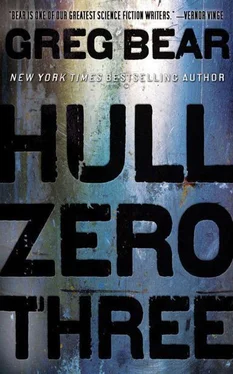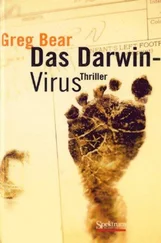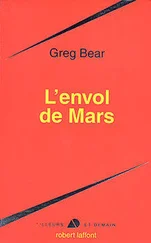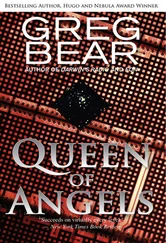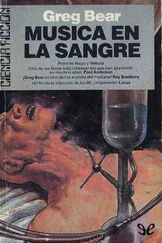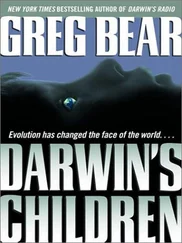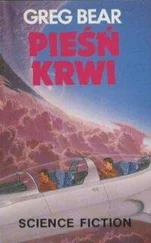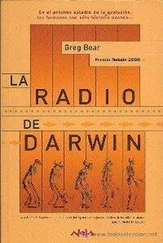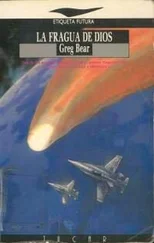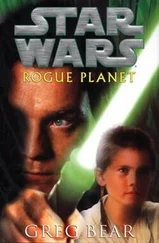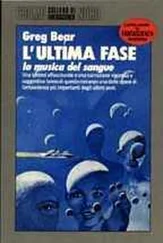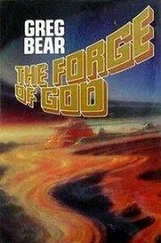“You shouldn’t do that,” she softly admonishes the Tracker, as if speaking to a child. The Tracker grunts and rattles ivory spines. “What’s this?” she asks.
Big Yellow swings himself through the hatch. “More dead folks,” he says from inside, his voice muffled. “Pretty far gone.” He tosses out three corpses, dry as husks. I don’t check to see if I’m one of them. I pull up to the hatch, then in, somersaulting slowly until my hand grabs a net.
We’re in a craft moored just aft of the control chamber. The small cabin is shaped like the inside of an egg, narrow tip near the hatch. It’s equipped with fine netting that reacts to our presence. Two more husks hang at the back, curled in each other’s arms. Big Yellow dislodges the pair, not bothering to disentangle them—just shoves them past me, past the spidery woman, through the hatch. Out and away.
The air is dry, with a touch of the scent of death. Still much better than the drifting fog outside. Big Yellow suggests we shouldn’t leave the hatch open for long.
The netting wants to serve—protect—guide. It pulls away from a pale blue hemisphere, then reveals a clear port about a meter in diameter. Again, we see the stars—and fifty or more kilometers away, the bow of another hull.
“It’s a transfer egg,” the spidery woman says. “Tsinoy, you’re a marvel. I missed this completely.”
“No time,” Tsinoy says. “Stuff coming.”
“But I need to remember how to use it,” she says.
The girl peeks in. “I hear a fight back there,” she says. “At least three more. They’re all going to die.”
Big Yellow shoves out of the netting. The girl leans aside with quirked lips as he flies through the hatch. The Tracker, however, is stuck—the netting doesn’t seem to know how to let loose of those ivory spines. Tsinoy squirms and rips and finally tears its way out, then follows. The girl gives it a wide berth.
“We could run the hull from that forward position,” the spidery woman says. She gives me a defiant look, well aware of her contradictions from a few hours before.
The girl looks on in concern as I exit. She wants me to stay—out of danger. The mist hits me full in the face as I follow Big Yellow’s swatch of color through the staging area. He’s fairly flying through the wreckage, the framework that holds the ruined ships, toward our former residence, and points aft.
Spin-up begins right now, of course, just to add to our joy.
I’m surprised by how adapted I’ve become to low-weight conditions. What little intellect I can manage between my leaping and vaulting consists of calculations on how hard I’d slam into something if I don’t grab this beam or that broken piece of frame and slow myself, how fast I can spin around a cable or a rail and deflect my trajectory—long, quick curves that get longer and more demanding as spin-up reaches maximum.
Of course, I’m not lucky enough to escape without slams and bruises—and a particularly bad miscalculation near the hatch to the wide domicile. I strike the wall and bounce away, stunned, then slowly fall outboard, until the spidery woman grabs my sleeve and, with surprising strength, hauls me to the hatch—a stretch of at least four meters.
“The girl’s right,” she says. “Hear that?”
I don’t. I’m not that sensitive. In awe and embarrassment, I thank her, and we follow Tsinoy and Big Yellow across the domicile, a quick enough trip—then back into the cap that covers the forward end of the gigantic water tank. We bound along the outer wall, great leaps barely planned, all adrenaline and ill-shaped instinct.
This time, the spidery woman flips herself in one bound and flies against the tank’s huge eye. The water is in full slosh mode, waves majestically spiraling, peaking, breaking off around the slowly rotating tube. Bubbles crack and smack against the eye’s inner surface, creating a cacophony I don’t remember from my first visit.
How anyone can hear anything is beyond me. Before I have much time to regret any of it, all for one and one for all, pain and stinging skin and eyes, we’ve passed through a series of hatches and one long tube, back to a large, cluttered spherical space outboard of the water tank—not any part of the Ship I’ve passed through before, I’m willing to swear.
This looks more like a ruined forest ball. I close my eyes tight, then spit on my sleeve and rub to clear my vision. Now I hear voices—faint, fading. Dead vegetation hangs limp and brittle from the crisscross of cabling, and a slow, stately rain of leaves and broken limbs and branches falls around us, kicked up by something half buried in an accumulation on the inboard side.
A mangled body glides by from where it briefly snagged on dead branches. A beaded trail of blood from a severed leg dutifully follows in its wake. The body’s head turns, eyes blinking, and I realize it’s still alive—a Scarlet-Brown, but this one seems to be female, or at least shaped differently. Then she passes below the light from the nearest hatch, and I look up to where she was and see, emerging from the outboard darkness—
More joy. An old friend—red claw. I reacquaint with what I first observed in distinctive parts—that claw, another like it, and more, half hidden; a quartet of crushing mouths set flat in a wide, dun-colored body. Tooth-edged reddish plates clack and scissor as at least a dozen spiky red arms reach out from the outer shell and grab and jerk inward whatever they touch—branches, bits of cable, the Scarlet-Brown’s missing leg still stuck in one grinding maw, the cloth-booted foot spinning round and round. It’s falling right toward me, maybe three blinks away, so I grab a cable through the pile of forest litter, tug myself left, and watch as the horror touches down, using claws and legs to cushion the fall with an unexpected, grim grace.
Grace is discarded as its limbs frantically shove aside debris, and the lifeless female. The mangled Scarlet-Brown is sucked away in the litter. The red horror spins about, claws raised, unable to gain traction in the litter’s shifting surface but obviously aimed in my direction.
Just me and it, everyone else out of sight. I hope they haven’t abandoned me, but how would that be any different from the sad histories of all my past selves, all my dead and frozen duplicates?
The horror pauses. Somehow finds a place to brace its limbs. Lifts itself out of the tangle and fragments.
A claw rises higher, swipes, and snicks, but only grazes my elbow, my hips.
Something even larger drops from the inboard volume of the forest ball. I can feel the mass of it but can’t make out details until it’s within the light. Large and sickly green, with red stripes and nested plates arranged every which way, each bearing more needle-sharp spikes. There’s an emerging theme. The Catalog, I think, is beginning to lack originality.
But I am wrong.
The new prodigy uncoils a long, thick ribbon. The ribbon twists and falls toward red claw, coiling and spiraling as if in a light breeze. Its tip flares and pushes out a pink pulp, aiming, spreading, and then attaching to the red back—the two nightmares are joined, as if one by itself weren’t bad enough.
Anchored, the ribbon whips in a jump-rope curve, shredding everything in its circuit. The whole assembly is less than four meters away, and the cable is about to cut me in half when Tsinoy leaps from the other side, lands on the red monster’s back, and grabs hold, paw-claws sucking down, burrowing. The Tracker’s muscles rearrange in a weird, snaky ballet.
Then it plunges its arms deep into the red shell, lifting, cracking, tearing, crushing. The whole scene terrifies me so deeply I’d rather be dead. I’m forced to look aside, where Big Yellow and the girl, her arms around his thick neck, bound along a clear stretch of curved wall, half pulling, half flying, carrying another body, yet another Knob-Crest, still alive but stunned, deep gouges and scratches around his face and neck, his clothing in tatters.
Читать дальше
